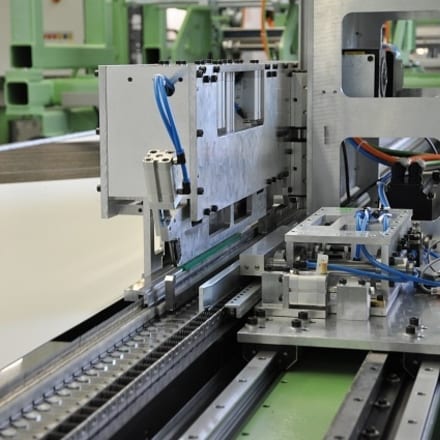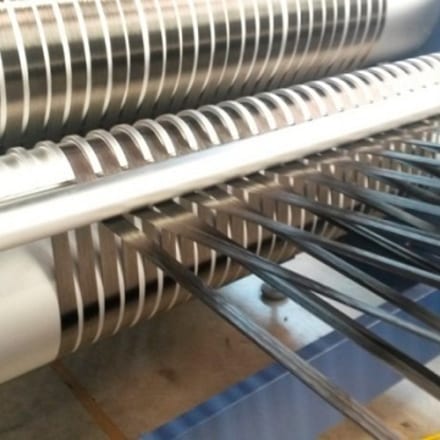Lightweight constructions make fast even faster
KARL MAYER Technische Textilien GmbH – a driving force and trendsetter in the carbon composites sector
The topics of energy efficiency and environmental protection are becoming more important during production and, together with their special requirements, are becoming motors for growth in the lightweight construction sector. This is especially true for the car industry.
As in the aviation industry, lightweight components are needed more and more in car production to reduce CO2 emissions. With annual growth rates of from 7 to 8 %, the global lightweight construction market is expected to reach €140 billion by 2020 in the transport sector alone – this is why the textile sector should look forward to the future optimistically. The components, with their low weight and high performance, are based on composites reinforced with textiles. For these demanding applications, the load-absorbing multiaxial textiles are made from carbon fibres and are produced on multiaxial warp knitting machines – preferably those manufactured by KARL MAYER Technische Textilien GmbH. This Chemnitz-based company is a leader in the production of specialised production equipment. It manufactures the COP MAX5 multiaxial warp knitting machine and the FSA 800 fibre spreading machine, which are aimed at the carbon composites sector in particular. What is more, this innovative manufacturer also supports certain sector initiatives like the C³ Project – a project sponsored by the German government for promoting textile-reinforced concrete, and the Arbeitsgemeinschaft Hybride Leichtbau Technologie (Working Group Hybrid Lightweight Technologies), set up by the Verband Deutscher Maschinen- und Anlagenbau, VDMA e.V. (German Engineering Federation). In a conversation with the press officer of the VDMA’s Trade Association, Jochen Schmidt, the Managing Director of KARL MAYER Technische Textilien and a member of the board of the Working Group, said that his company was fully committed to the promising lightweight construction sector.
The must–haves for processing carbon
KARL MAYER Technische Textilien developed the COP MAX5 to cater for the special demands of processing sensitive carbon fibres, and it can produce multiaxial textiles having very low weights per unit area. Weights of less than 70 g/m² per layer can be achieved when using 12K carbon rovings.
The COP MAX5 operates with parallel weft insertion and has three variably adjustable weft laying systems as standard. By using modern materials and complex, sophisticated devices, the weft can be inserted gently and at a high frequency, and is fed to the knitting process either online or offline. The two versions basically differ in terms of the way the spreading process operates – a step in which the carbon fibre material is equalised and prepared so that it can absorb forces optimally during subsequent use.
With the online version, the carbon rovings are removed from bobbins on a tangential creel and spread directly during the weft insertion process. The material is, therefore, removed continuously and at a constant tension. With the offline version, the pre-spread, dry, unidirectional (UD) tapes are removed from flanged bobbins and delivered to the weft insertion point. The UD tapes are produced in a preliminary stage on a fibre spreading machine, preferably the FSA 800. This machine was developed for spreading continuous filament yarns, and the assembly does not require any fixing means, such as an adhesive grid.
Whether the online or offline process is used, the carbon fibre material delivered is processed on the COP MAX5 at a constant tension and uniformity using intelligent technical systems. These well-thought-out features include an integrated, efficient layer support system, optimised feeding and laying principles based on a cut weft yarn, and specially designed hooking and transport elements.
Applications – somewhere between practice and vision
The market is extremely impressed by the benefits offered by the composites machines manufactured by KARL MAYER Technische Textilien. This subsidiary of KARL MAYER already achieves from 15 to 20 % of the Group’s turnover, and supplies a number of different sectors. “The biggest sector using carbon is still the aviation industry, followed closely by the car industry. Growth is particularly good here. But carbon is also being used increasingly in the wind turbine sector,” says Jochen Schmidt. The wind turbine sector mainly uses multiaxial textiles made from glass to produce fibre-reinforced plastic composites for the rotor blades. “As the blade rotates, the centrifugal forces are extremely high, and the multiaxial textiles are used to provide the necessary strength,” says Jochen Schmidt. Steel, which has the required strength but is comparatively heavy, is not a suitable alternative in this application, as it is in many other industrial sectors. For these reasons, Jochen Schmidt wants his company to become more involved with the carbon composites sector. “The aim is to press forward with further developments on the carbon fibre market, since we see such a huge potential there. We are expecting the carbon sector to grow continuously over the next few years,” says the Managing Director. The big hope lies with building the machines in particular. “It is worth using carbon when parts are accelerated quickly, or when large masses have to be moved,” he says. Jochen Schmidt also considers the topic of textile-reinforced concrete, in which multiaxial carbon textiles rather than steel are used for reinforcing concrete. “Carbon-fibre reinforcements are lighter and have a much better load-bearing capacity than conventional reinforcing steel,” says the Managing Director. And what is more, the material does not rust. This means that it is no longer necessary to use a heavy concrete covering to prevent corrosion – which reduces the thickness of the components and thus the amount of concrete needed, which also saves resources. The thin concrete structures can also be shaped more freely and used in constructions that it has not been possible to use them in until now. The only downside is that carbon is relatively expensive. However, according to Jochen Schmidt, there are many applications in which the material savings are so great, that it is worth using carbon. One example is for the repair and renovation of bridges. In this case, the steel mats, which are underlaid with concrete, are replaced by multiaxial carbon textiles to save costs where possible, and also to promote sustainability in the building sector.
Back to overview

